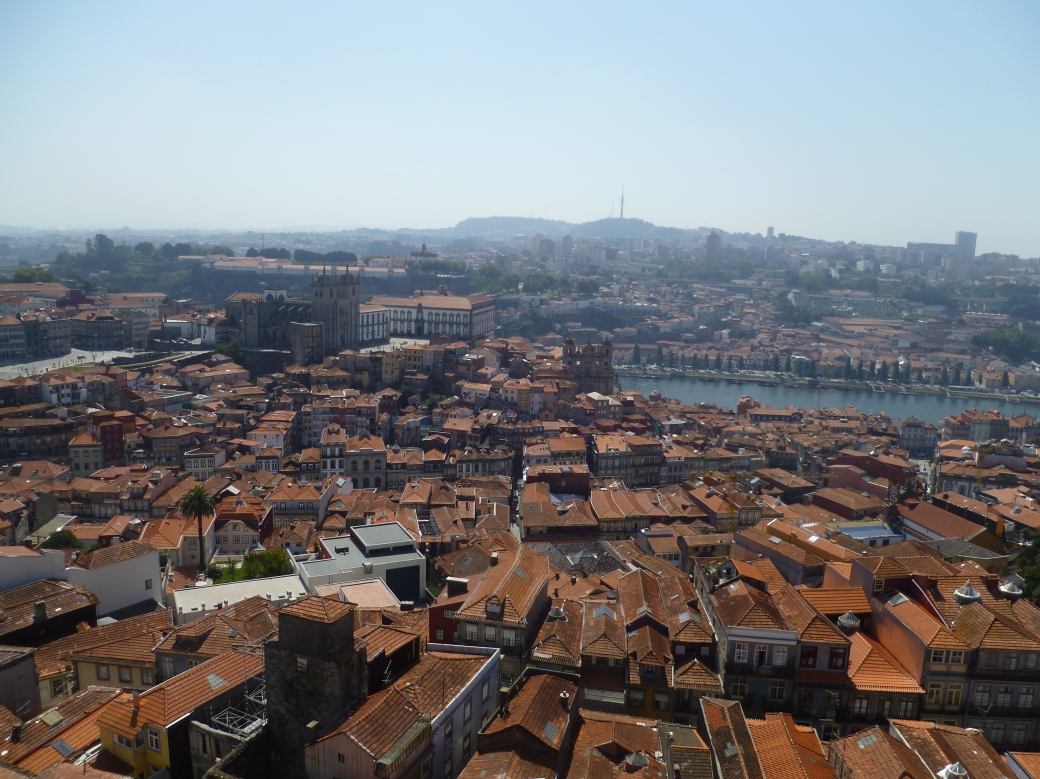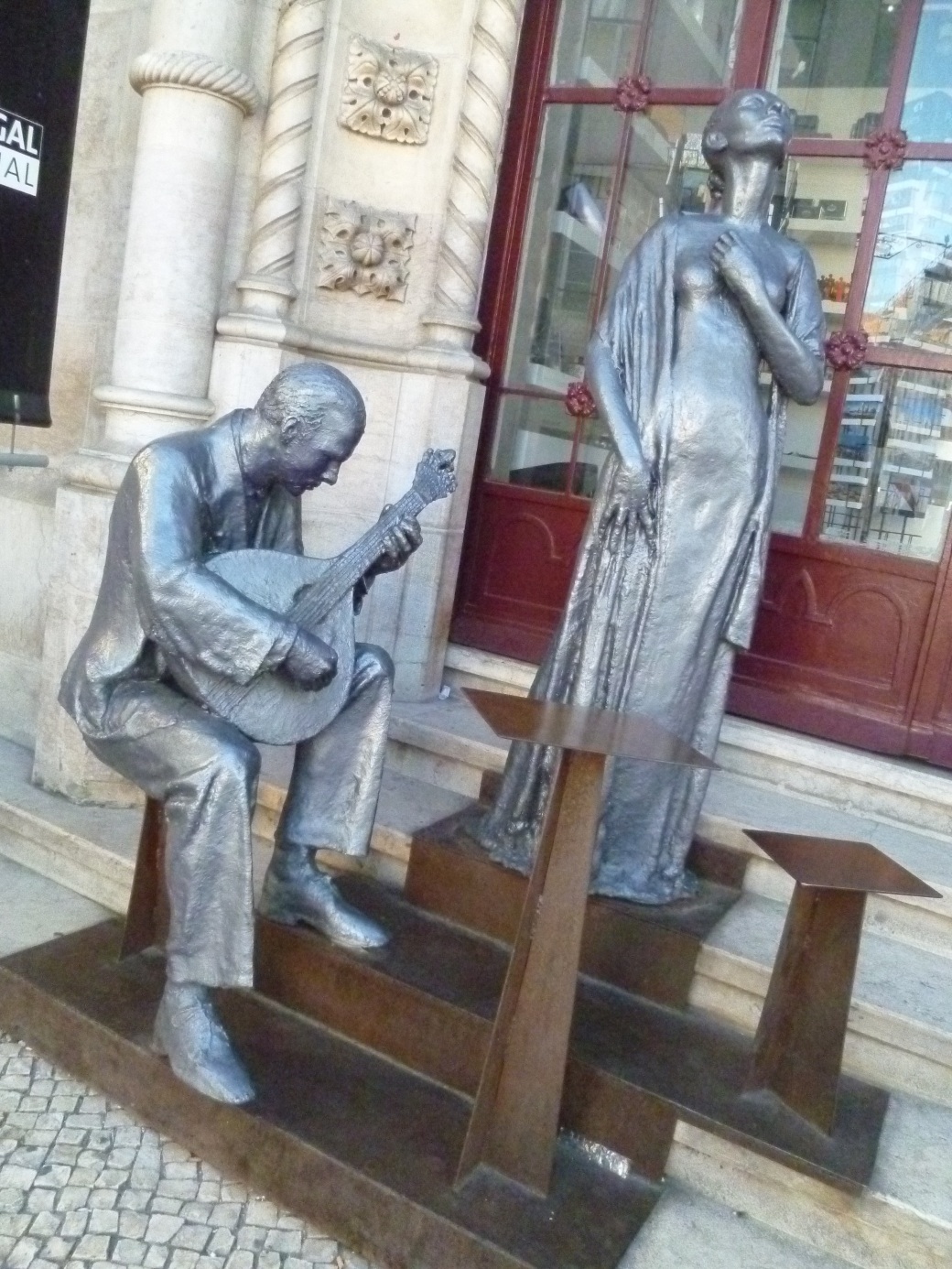Dates: 31 August – 7 September 2014.
The itinerary for this trip involved three days in Oporto (Porto) and five days in Lisboa (Lisbon), with a three hour train journey to take us from north to south.
We arrived late in Porto and after climbing the hill to our accommodation we headed straight back out to take a look around.
The Portugese stock exchange, Palácio da Bolsa:

Ponte Luís I over the Douro river:

That’s a nice bike:

Sé do Porto (Porto Cathedral):

Newspaper seller sculpture:

With our one full day in Porto we walked the hilly and compact city. First up was the ornate City Hall, or Câmara Municipal do Porto:

National hero Dom Pedro IV on Praça da Liberdade (Liberty Square):

The famous Livraria Lello bookshop from the outside:

The inside is pretty incredible:

Opponent of fascism, bishop António Ferreira Gomes:

I’m a huge fan of urban trams:

The Clérigos Tower:

Views from the elevated Miradouro da Vitoria area situated between the Clérigos Tower and Porto Cathedral :


A view over the Douro:

The part of the city on the north (hilly) side of the Douro is a warren of cobbles streets and tightly-packed homes.
One such home under the Ponte Luís I:

The bridge passes just over the roof of some homes:

Trams go across the upper deck and cars go along the lower deck. Pedestrians can use either:

The Fonte do Cubo in the centre of a very colourful Praça Ribeira, just off the road that runs along the Douro:

After exploring the northern side of the Douro we headed across to the southern side for some port and wine tasting.
A view back towards the hilly northern side:

Little boats on both banks of the river:

Red wine, port, chocolate and biscuits. The wine and port uses water from the Douro river. Delicious:

After the tasting we took the short cable car (Teleférico de Gaia) up to Jardim do Morro:


The view from the top deck of the Luís I bridge:


The view of Ponte do Infante in the distance from atop Ponte Luís I:

As the sun began to set we headed out of the city centre to the several beaches that look out to the Atlantic. We started with Praia do Carneiro and worked our way north.
A lovely dusky evening:



Praia de Matosinhos and the curious Anémona sculpture:



The next day we were due to catch the train south to Lisbon, so we had once last wander around Porto, heading up the Clérigos Tower and then took a boat trip on the Douro river.
The Portuguese love their blue and white tiles. One such example is the Igreja do Carmo (Carmo Church):

Some fun street/shop “art”:

Some spectacular vistas from the top of the 76 metre high bell tower of the Clérigos Tower.
The view north:


The view south:


So much terracotta, with Sé do Porto (Porto Cathedral) in full view and the Episcopal Palace (white walled building) to the right:

After those views at altitude we headed down to the river:


The gorgeously colourful buildings on the Cais da Estiva, which runs parallel to the river, with the Episcopal Palace looming above:

On the boat, we traveled east, heading inland first:

Ponte de Maria Pia (almost identical to Ponte Luís I, but just missing the lower deck) with the modern train-carrying Ponte de São João in the background:

After doing a u-turn, the boat headed west, passing the beautiful Cais da Estiva:

The view back to the centre with the Claustros do Mosteiro da Serra do Pilar (a white monastery with terracotta roof) high on the right of the bridge:

We left Porto late in the afternoon on the train and arrived not long after 21.00 in Lisbon. After finding our cool little apartment we headed out for a quick look around.
All lit-up. Igreja de São Vicente de Fora (church) on the left, the Panteão Nacional / Church of Santa Engrácia in the centre, and the main train station, Santa Apolónia, on the right:

The views from the elevated Miradouro de Santa Luzia area (near our accommodation) out to the Tagus estuary on our first morning in Lisbon:


The same view as the night we arrived, but in glorious sunshine. Igreja de São Vicente de Fora on the left, the Panteão Nacional / Church of Santa Engrácia in the centre, and the main train station, Santa Apolónia, on the right:

After breakfast we headed out to explore the city, and we started by climbing up Castelo de São Jorge and checking out the view over the Tagus river towards the neighbouring city of Almada.
An interesting archway:

The view of the Tagus river and the Ponte 25 de Abril (renamed in 1974 after the date of the revolution that overthrew Oliveira Salazar) that connects Lisbon and Almada:

The entrance to the Moorish Castelo de São Jorge:

Igreja de São Vicente de Fora and the Panteão Nacional / Church of Santa Engrácia in a line out to the Tagus:

As with Porto, Lisbon is a sprawl of terracotta:

Amazingly, in the gardens around the caste grounds are peacocks, and we managed to find a peachick:

A random statue guarding the local wildlife:

After a quick beer we headed off to see Mosteiro dos Jerónimos via tram:

Mosteiro dos Jerónimos:


From there were took a short walk to the marina, Doca de Belém, in search of the monument to Portuguese explorers, the Padrão dos Descobrimentos:

The Rose Compass, which depicts a world map as it was known in the 1500s:


A view back to the monument with the Ponte 25 de Abril in the background:

The walk along the river bank took us to the ceremonial gateway to Lisbon for explorers, Torre de Belém:


The nearby Monumento aos Combatentes do Ultramar (Monument to the Overseas Combatants):

Some street art:

An unusual form of a city tour:

We headed back to the city centre and came across the very familiar looking Sé de Lisboa, which is a spit of the one in Porto:

One example of Lisbon’s blue tiled buildings:

We thought this looked quite cool:

For day two in Lisbon we left the coastal area and headed north, inland.
The Campo Pequeno bullring:

We then headed to take a look at a section of the famous 18th century aqueduct, Aqueduto das Águas Livres:


Next-up we strolled over to Praça Luís de Camões, a pretty little square with two statues, one being of Portugal’s most famous poet, Luís de Camões:


A tribute to another Portuguese poet, Fernando António Nogueira Pessoa:

Afterwards we spent some time at the nearby Museu Arqueológico do Carmo (archaeological museum) which used to be a Gothic church. Next door is the imposing
Convento do Carmo:

A view down to the Praça Dom Pedro IV (popularly known as Praça do Rossio) and the national theatre, Teatro Nacional D. Maria II:

A side street off the square, looking up at Castelo de São Jorge on the hill:

We walked down Rua Augusta and Arco da Rua Augusta can be seen in the distance:


The arc with the statue of Dom José I in the distance:

The ceiling of the arc:

Praça do Comércio:

Within minutes of being on the square we were offered various types of drugs by various shading characters, but with a police presence in and around the area, they moved on following a swift decline.
The view from the viewing platform on the Arco da Rua Augusta:



After a bite and a drink at one of the cafes on the square we headed back up towards Praça Dom Pedro IV but veered off to Praça da Figueira. Dom João I:

The fancy entrance to Rossio train station:

Our third day in Lisbon was a bit more relaxed as we headed out of town on the urban train to the Sintra area, north west of central Lisbon.
More blue mosaics:



Another Moorish castle, Castelo dos Mouros looming above the town of São Martinho:

The white building with twin white spires is the Sintra National Palace:

Mucking about:


More beautiful blue tiles:


The buildings of São Martinho looked pretty in the sunshine of another glorious day:


More great views, in tile and real life:



A monument celebrating Fado music:

We headed back to the city centre for the evening and spent time navigating the labyrinth of alleyways in the Alfama area:


We started late on our final full day and headed to the Jardim da Estrela:


The famous band stand:

Geese, ducks and baby ducks:



From the gardens we stopped by the Palácio Nacional da Ajuda:

We then strolled over to the nearby Jardim Botânico d’Ajuda:


Afterwards we made the trek up to the Amoreiras area to take in the view from another part of the city.
The tram helped with the ascent:

More cute alleyways:

Castelo de São Jorge in the distance:


Liz buying a ticket from the statue dedicated to the lottery sellers of Lisbon:

We only had a few hours on our last day before we had to head to the airport. Two final pictures on yet another gorgeous day:


Both Porto and Lisbon were beautiful places to visit. Both are ideally situated with rivers on one side and leafy hilly areas on the other, and both possess wonderfully characterful gardens, squares and alleyways. And the trams go everywhere!